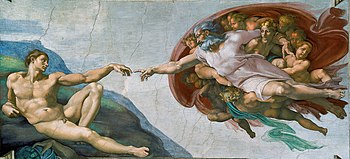
Back Fresko Afrikaans Fresko ALS تصوير جصي Arabic الفريسكو ARZ Freska Azerbaijani Фрэска Byelorussian Фрэска BE-X-OLD Стенопис Bulgarian ফ্রেস্কো Bengali/Bangla Freska BS

Fresco (pl. frescos or frescoes) is a technique of mural painting executed upon freshly laid ("wet") lime plaster. Water is used as the vehicle for the dry-powder pigment to merge with the plaster, and with the setting of the plaster, the painting becomes an integral part of the wall. The word fresco (Italian: affresco) is derived from the Italian adjective fresco meaning "fresh", and may thus be contrasted with fresco-secco or secco mural painting techniques, which are applied to dried plaster, to supplement painting in fresco. The fresco technique has been employed since antiquity and is closely associated with Italian Renaissance painting.[1][2]
The word fresco is commonly and inaccurately used in English to refer to any wall painting regardless of the plaster technology or binding medium. This, in part, contributes to a misconception that the most geographically and temporally common wall painting technology was the painting into wet lime plaster. Even in apparently buon fresco technology, the use of supplementary organic materials was widespread, if underrecognized.[3]
- ^ Mora, Paolo; Mora, Laura; Philippot, Paul (1984). Conservation of Wall Paintings. Butterworths. pp. 34–54. ISBN 0-408-10812-6.
- ^ Ward, Gerald W. R., ed. (2008). The GroveEncyclopedia of Materials and Techniques in Art. Oxford University Press. pp. 223–5. ISBN 978-0-19-531391-8.
- ^ Piqué, Francesca (2015). Organic materials in wall paintings : project report. Los Angeles: Getty Conservation Institute. ISBN 978-1-937433-29-1. OCLC 944038739.
© MMXXIII Rich X Search. We shall prevail. All rights reserved. Rich X Search